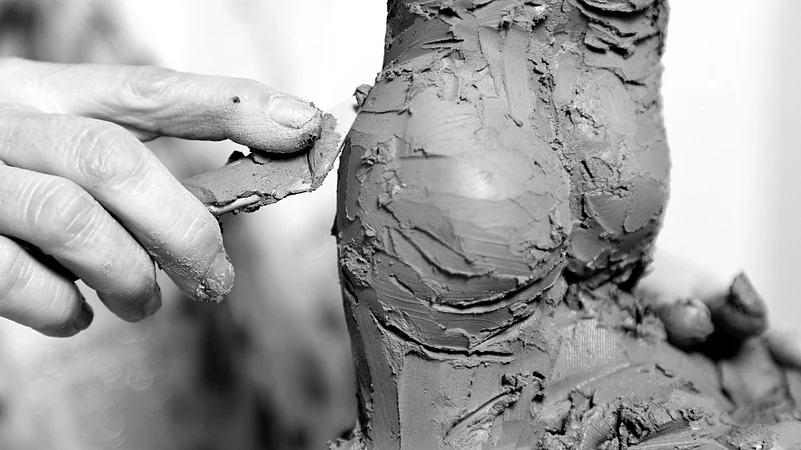“...imperfection is in some sort essential to all that we know of life. It is the sign of life in a mortal body, that is to say, of a state of progress and change. Nothing that lives is, or can be, rigidly perfect; part of it is decaying, part nascent ... And in all things that live there are certain irregularities and deficiencies which are not only signs of life, but sources of beauty. All admit irregularity as they imply change; and to banish imperfection is to destroy expression, to check exertion, to paralyse vitality.” — John Ruskin, The Stones of Venice.
That year, the city seemed to suffer from a never-ending summer. The air turned heavy with dog-sweat and pollen dust. Riots of Bougainvillaea leapt up from granite recesses. The sky swelled up in a sinister shade of apricot. Shabby cafés lit up with gay chatter, and a dirty-green tenement on a cul-de-sac moist with overbearing sewage stench saw a filament flicker.
Amid the chiaroscuro of his sour-cream studio, stood Pygmalion. A closer peek, and you could catch his thumb and right index engaged in the relentless pursuit of sculpting what he would deem the most perfect nipples in all the continent.
At first it did not seem like a tough feat — a few typical tugs, a dash of smooth strokes — nipples did not require much.
But these were destined to be the most perfect nipples in all the continent, and demanded greater toil.
He had been trying to sculpt the most beautiful woman for half a decade now, and summer had never left the city since the day he started. Under the waxing and waning of torrid nights, he had fondled out of Chinese clay the soft nuances of a woman’s body — hips that would make Botticelli blush, and breasts that would make Raphael quiver with envy.
However, when an unruly zephyr momentarily punctured the con game of that incessant summer; and few Sanskrit leaves floated upon a lazuli lake, tips curled in fugitive sublimity — Pygmalion would stare at quizzical sun rays falling on the porcelain navel, and heave a sigh.
Something was missing, he knew. Yet, as he fixed his gaze upon the lilt of her waist or the relentless whiteness of her thighs — nothing seemed amiss.
As the day would draw to slow close, and marmalade streaks would die out from the balcony pelted white with century-old pigeon shit, sweat would pool on Pygmalion’s furrowed brow — each drop a lone edelweiss.

***
When I remember her, I remember the evening she was naked and fumbling like a birdling.
I asked for her name (something other than ‘kitten’ or ‘lassie’), to which she replied she knew not.
‘Would you like me to give you a name, then?’ I flashed her an indulgent smile- paternal, almost.
She shook her wispy head vehemently, her eyes bright with half-scared defiance.
If I ever need a name, she mumbled, I would like to give one to myself.
When I asked her what name she would prefer, she stared into me with bewildered eyes.
That I needn’t decide. She concluded, unsure. I would like to keep my options open, I guess. I could be anyone.
I had joked about her freckles that day (something about her camouflaging into my mildewy wall). She had a schoolboy’s laughter — unscrupulous, contagious, rollicking fits. Her teeth were tinted a mother-of-pearl yellow. She had kind black eyes. On her shoulders were rough, ruddy patches.
‘How did you get these?’ I asked her.
***
At times, I wish she told me. But at other times, I know too well why she didn’t.
She had wanted to leave my options open, I guess. It could have been anything.
As I etch a tiny purplish bruise, a half-moon nail mark upon my still-lifeless altar of porcelain, I can hear the swallows returning to their broken nests on cirrus branches.
The rain follows.
(Ritoshree Chatterjee pursues her undergraduate degree in English literature and struggles to locate herself through writing amidst the chaos. Views expressed in this article are personal and may not necessarily reflect the views of Outlook Magazine.)
















